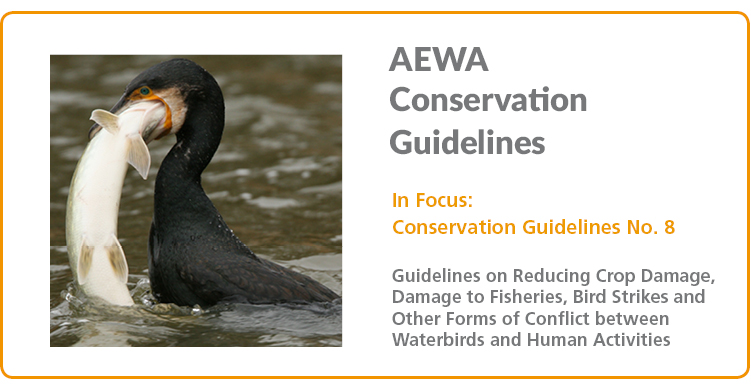In Focus: AEWA Conservation Guideline No. 8 - Guidelines on Reducing Crop Damage, Damage to Fisheries, Bird Strikes and Other Forms of Conflict between Waterbirds and Human Activities

© Marcel Langelaan
Bonn, 14 December 2017 - In many parts of the AEWA area, local reductions in hunting pressure, the creation of bird sanctuaries and the expansion of rubbish tips have led to increased survival rates amongst some species of birds. This has led to significant increases in several populations of waterbirds in recent decades. This development, coupled with the intensification of agriculture, aquaculture, commercial and recreational fisheries, as well as aviation, have led to greater conflict between some waterbird species and human activities.
Three main types of damage to human interests caused by waterbirds can be distinguished: crop damage, e.g. through grazing of cereal crops by ducks and waders; damage to fisheries especially damage to aquaculture ponds; bird strikes, i.e. collisions between single birds or flocks of birds and fixed-winged aircraft or helicopters.
International cooperation is required to address these conflict situations whilst taking into consideration that critically small populations of waterbirds may become threatened as a result of the loss of individuals due to collisions with aircraft or accidental capture in fishing nets, as well as through measures taken to reduce damage caused by the birds.
In Paragraph 4.3.2 of the AEWA Action Plan, Parties are required to endeavour to gather information on the damage, in particular to crops, caused by populations listed in Table 1, and report the results to the Agreement Secretariat. In paragraph 4.3.3, Parties are required to cooperate with a view to identifying appropriate techniques to minimize the damage, or to mitigate the effects of damage, in particular to crops, caused by populations of waterbirds listed in Table 1.
These guidelines examine the major causes of conflict between migratory waterbirds and agriculture, fisheries and aviation, outline procedures for investigating the problems, and, last but not least, suggest a number of measures that can be taken to reduce the damage.
For more information please visit:
http://www.unep-aewa.org/publications/technical-publications?field_publication_type_tid=369
Last updated on 14 December 2017


